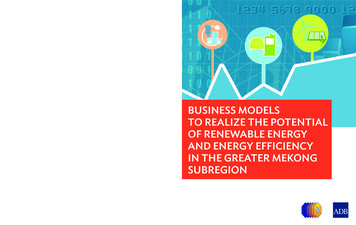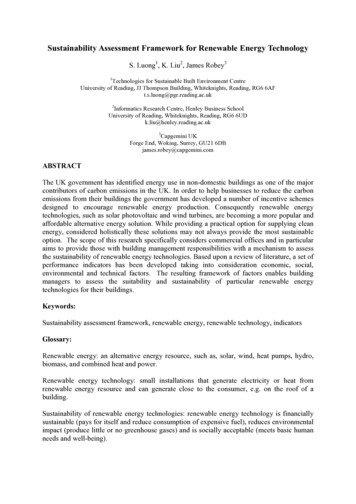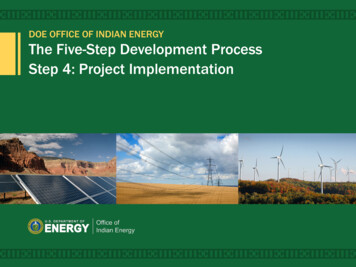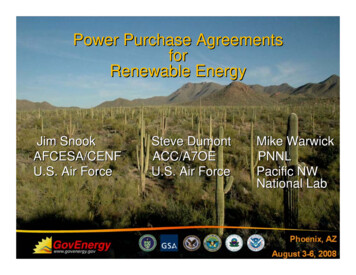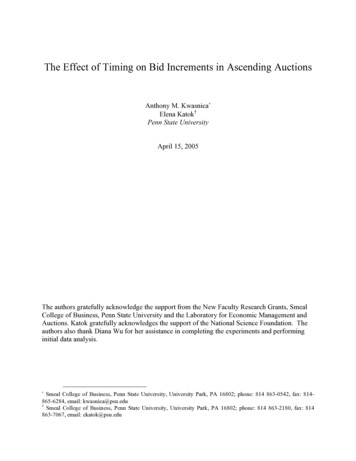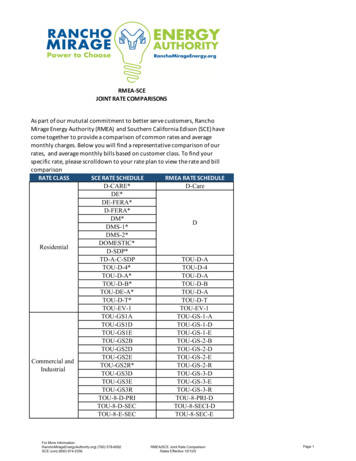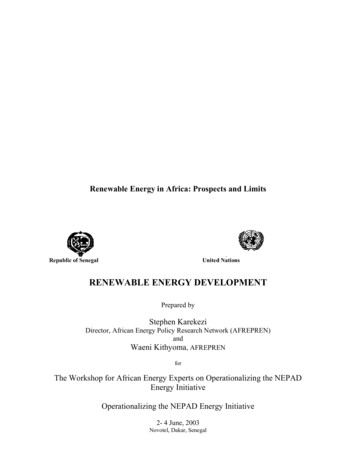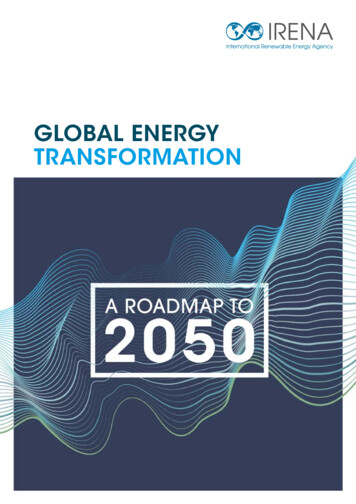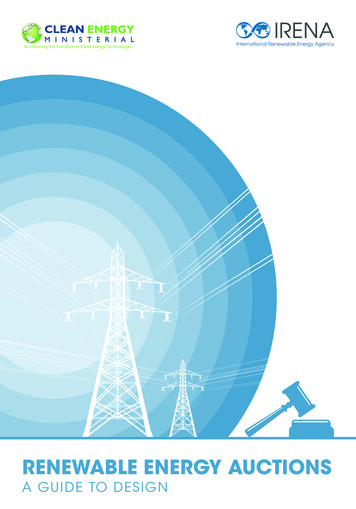
Transcription
Accelerating the Transition to Clean Energy TechnologiesRENEWABLE ENERGY AUCTIONSA GUIDE TO DESIGN
CopyrightUnless otherwise indicated, material in this publication may be used freely, shared or reprinted, butacknowledgement is requested.This publication should be cited as: IRENA and CEM (2015), Renewable Energy Auctions – A Guide toDesign.About IRENAThe International Renewable Energy Agency (IRENA) is an intergovernmental organisationthat supports countries in their transition to a sustainable energy future, and serves as theprincipal platform for international co-operation, a centre of excellence, and a repositoryof policy, technology, resource and financial knowledge on renewable energy. IRENApromotes the widespread adoption and sustainable use of all forms of renewable energy,including bioenergy, geothermal, hydropower, ocean, solar and wind energy, in the pursuit ofsustainable development, energy access, energy security and low-carbon economic growthand prosperity. www.irena.orgAbout CEMThe Clean Energy Ministerial (CEM) is a high-level global forum to promote policies andprograms that advance clean energy technology, to share lessons learned and best practices,and to encourage the transition to a global clean energy economy. Initiatives are based onareas of common interest among participating governments and other stakeholders.Acknowledgements‘Renewable Energy Auctions: A Guide to Design’ is a project of IRENA and the Multilateral Solarand Wind Working Group, an initiative of the CEM led by Denmark, Germany and Spain.Authors: Rabia Ferroukhi, Diala Hawila, Salvatore Vinci and Divyam Nagpal (IRENA).Contributing authors: Luiz Augusto Barroso, with input from Gabriel Cunha, Rafael Ferreira,Arina Anisie and João Pedro Bastos.Reviewers: Henning Wuester, Elizabeth Press, Arslan Khalid, Troy Hodges, Ghislaine Kiefferand Paul Komor (IRENA), Gauri Singh (Government of Madhya Pradesh, India), Luiz Maurer(International Finance Corporation) and Pedro Linares (Comillas Pontifical University), theFederal Ministry for Economic Affairs and Energy of Germany (BMWi), the Ministry of Climate,Energy and Building of Denmark, the Spanish Institute for the Diversification and Saving ofEnergy (IDAE), and the US National Renewable Energy Laboratory (NREL).For further information or to provide feedback, please contact IRENA’s Policy Unit, P.O. Box236, Abu Dhabi, United Arab Emirates; Email: info@irena.org.This guidebook comprises of six chapters and can be downloaded from www.irena.org/Publications.DisclaimerWhile this publication promotes the adoption and use of renewable energy, IRENA and the CEM do not endorse anyparticular project, product or service provider. The designations employed and the presentation of materials herein do notimply the expression of any opinion whatsoever on the part of the International Renewable Energy Agency (IRENA) orthe Clean Energy Ministerial (CEM) concerning the legal status of any country, territory, city or area or of its authorities, orconcerning the delimitation of its frontiers or boundaries.
RENEWABLE ENERGY AUCTIONSA GUIDE TO DESIGNCHAPTERS1. SUMMARY FOR POLICY MAKERS2. RENEWABLE ENERGY POLICIES AND AUCTIONS3. AUCTION DESIGN: DEMAND4. AUCTION DESIGN: QUALIFICATION REQUIREMENTS5. AUCTION DESIGN: WINNER SELECTION PROCESS6. AUCTION DESIGN: SELLERS’ LIABILITIES
About the reportIn 2013, IRENA carried out its first study on the topic, Renewable Energy Auctionsin Developing Countries, which highlighted key lessons learned from developingcountries that have implemented auctions, namely Brazil, China, Morocco, Peru andSouth Africa. The report presented an analysis on auction design options, as well asbest practices on the implementation of auctions in the form of recommendationsfor policy makers. Furthermore, IRENA’s Adapting Renewable Energy Policies toDynamic Market Conditions report reiterated the importance of auctions in today’selectricity markets.Building on this work, the present guidebook assists policy makers in understandingthe implication of different approaches to renewable energy auctions. Structuredaround four key design elements, it offers a range of choices and makesrecommendations to facilitate optimal decision-making in a given context.The analysis focuses on potential challenges that need to be addressed, andthe guidebook assesses alternatives that may be considered for each auctiondesign element. Achieving objectives of renewable energy policies, such as costeffectiveness, security of supply, and contributions to socio-economic development,among others, is thoroughly discussed. The guidebook presents the main trade-offsinvolved in decisions on auction design (e.g. between reduction of barriers to entryand discouragement of underbuilding, or between design simplicity and the abilityto reflect exact preferences regarding the technology mix and spatial distributionof the renewable energy capacity to be contracted) and offers guidance on how tofind an optimal balance that takes into account the objectives and circumstances ofeach jurisdiction.The analysis is supported by specific country experiences, representing differentcontexts and circumstances, and offers lessons learned and best practices on howgovernments can design and implement auctions to meet their objectives. Dividedinto six chapters, this guidebook supports policy-makers in designing renewableenergy auctions tailored to their needs.Chapter 1 (Summary for Policy Makers) synthesises the findings and presents themain conclusions and policy recommendations for the design of auctions.Chapter 2 (Renewable energy policies and auctions) contextualises auctions withinthe larger realm of renewable energy support schemes. It provides an overview ofrecent international trends in renewable energy policies, highlighting the role thatauctions have been playing in many electricity markets worldwide. This analysis iscomplemented by an overview of the key strengths and weaknesses of auctions.
The next four chapters discuss different components that make up a renewableenergy auction scheme, presenting analyses of past experiences and lessons learned.The key elements of auction design have been classified into four categories, eachof them analysed in a separate chapter.Chapter 3 (Auction Design: Demand) addresses design alternatives involving theauction demand, which comprises key decisions on what exactly is to be purchasedin the auction, and under what conditions.Chapter 4 (Auction Design: Qualification Requirements) analyses the qualificationrequirements to determine which suppliers are eligible to participate in an auction,as well as the conditions with which they must comply and the documentationrequired prior to the bidding stage.Chapter 5 (Auction Design: Winner Selection) discusses design choices regardingthe winner selection, which is at the heart of the auction process and involveshandling the bidding and clearing rules, as well as awarding the winners’ products.Chapter 6 (Auction Design: Sellers’ Liabilities) addresses the seller’s liabilities,primarily associated with the characteristics of the product being auctioned, alongwith responsibilities and obligations stipulated in the auction documents.The geographical scope of the work is global, as the recommendations from theguidebook could apply to all countries that are considering adopting auctionsschemes. The report is focused on electricity, and mostly on solar and wind auctions.
GlossaryThe following definitions reflect the nomenclature used by the InternationalRenewable Energy Agency (IRENA) and are strictly related to the renewable energyindustry; definitions used by other organisations and publications may vary.Auction: Auctions refer to competitive bidding procure ment processes for electricityfrom renewable energy or where renewable energy technolo gies are eligible. Theauctioned product can be either capacity (MW) or energy (MWh).Auction demand bands: Different categories within the total demand of an auctionthat require specific qualification requirements for submitting the bid (e.g. demandbands dedicated to specific technologies, project sizes, etc.).Auctioned volume: The quantity of installed capacity (e.g. MW) or electricitygeneration (e.g. MWh) that the auctioneer is aiming to contract through the auction.Auctioneer: The entity that is responsible for setting up the auction, receiving andranking the bids.Bid: A bidder’s offer for the product awarded in the auction – most usually a powerpurchase agreement for the renewable energy generation or capacity.Bidder: A physical or juridical entity that submits its offer in the auction process.Also referred as project developer, seller.Levelised cost of electricity (LCOE): The constant unit cost of electricity per kWhof a payment stream that has the same present value as the total cost of buildingand operating a power plant over its useful life, including a return on equity.Power Purchase Agreement (PPA): A legal contract between an electricitygenerator (the project developer) and a power purchaser (the government, adistribution company, or any other consumer).Project developer: The physical or juridical entity that handles all the tasks formoving the project towards a successful completion. Also referred as seller andbidder, since the developer is the one who bids in the auction.Off-taker: The purchaser of a project’s electricity generation.Overcontracting capacity: Contracting more capacity than the auction volume.Underbidding: Offering a bid price that is not cost-recovering due to high competitionand therefore increasing the risk that the projects will not be implemented.Underbuilding: Not being able to bring the project to completion due to underbidding.Undercontracting capacity: Contracting less capacity than the auction volume.
AcronymsANEELAgência Nacional de Energia Elétrica (Brazil)BNEFBloomberg New Energy FinanceBNDESBrazilian National Development BankCCEECâmara de Comercialização de Energia Elétrica(Chamber for Commercialisation of Electrical Energy, Brazil)CODCommercial Operation Date (or deadline)CSPConcentrated Solar PowerDEADanish Energy AuthorityDEWADubai Energy and Water AuthorityDOEDepartment of Energy (South Africa)EIAEnvironmental Impact AssessmentECEuropean CommissionEPCEngineering, Procurement and ConstructionEPEEmpresa de Pesquisa Energética (Energy ResearchCompany, Brazil)EUEuropean UnionFECFirm Energy CertificatesFIPFeed-In PremiumFITFeed-In TariffGDPGross Domestic ProductGNI/CAPGross National Income per CapitaIEAInternational Energy AgencyIOUInvestor-Owned UtilityIPPIndependent Power ProducerkWhkilowatt-hourLCRLocal content requirements
MASENAgence Marocaine de l’énergie Solaire (MoroccanAgency for Solar Energy)MEMEEMinistry for Energy, Mines, Water and the Environment(Morocco)MENMinisterio de Energía y Minas de Perú (Ministry ofEnergy And Mines of Peru)MMEMinistério de Minas e Energia (Ministry of Mines andEnergy, Brazil)NDRCNational Development and Reform Commission (China)NEANational Energy Administration (China)NERSANational Energy Regulator of South AfricaNFFONon Fossil Fuel Obligation (UK)NREAPNational Renewable Energy Action PlanNRELNational Renewable Energy LaboratoryNSMNational Solar Mission (India)PPAPower Purchase AgreementPROINFAProgramme of Incentives for Alternative ElectricitySources (Brazil)PVPhotovoltaicRAMRenewable Auction MechanismRECRenewable Energy CertificateRPORenewable Purchase ObligationRPSRenewable Purchase StandardREIPPPRenewable Energy Independent Power ProducerProcurement (South Africa)TSOTransmission System OperatorVGFViability Gap FundingWTOWorld Trade Organisation
Accelerating the Transition to Clean Energy TechnologiesRENEWABLE ENERGY AUCTIONS:A GUIDE TO DESIGNSUMMARY FOR POLICY MAKERSSUMMARY FOR POLICY MAKERS 1
Contents1SUMMARY FOR POLICY MAKERSABOUT THE REPORT 101.1TRENDS IN RENEWABLE ENERGY POLICY 131.2STRENGTHS AND WEAKNESSES OF AUCTIONS 141.3INCREASING COMPETITION FOR A COST-EFFICIENT MECHANISM 16Diversity of competing technologies 16Volume auctioned 19Level of participation of bidders 20Preventing collusion and price manipulation 231.4ENSURING THAT PARTICIPATION IS LIMITED TO BIDDERS THATCAN SUCCESSFULLY MEET THE AUCTION’S GOALS 27Ensuring the successful development of the renewableenergy project 27Ensuring that the renewable energydeployment goals are reached 32Ensuring socio-economic development throughrenewable energy deployment 341.5POLICY RECOMMENDATIONS 384 RENEWABLE ENERGY AUCTIONS - CHAPTER 1
FiguresFigure 1.1Countries that have implemented renewable energyauctions by early 2015 (in blue) 14Figure 1.2Categories of auction design elements 16TablesTable 1.1Summary comparison of technology requirements 18Table 1.2Summary comparison of cost allocation and contract off-taker 22Table 1.3Systematic auctions and the learning curve impact 24Table 1.4Summary comparison of bidding procedures 25Table 1.5Summary comparison of reputation requirements 28Table 1.6Summary comparison of the grid access permit requirements 35Table 1.7Local content requirements in auctions 36SUMMARY FOR POLICY MAKERS 5
BoxesBox 1.1Categories of auction design elements 17Box 1.2Competitive demand band auctions in California 18Box 1.3Price sensitive volume auctioned in the Netherlands 19Box 1.4Compliance rules and delay penalties in Peru 20Box 1.5Centralised project licensing in Denmark 21Box 1.6Regular auctioning scheme in South Africa and India 24Box 1.7The Brazilian hybrid auctions 25Box 1.8Price ceilings in South Africa and India 26Box 1.9Strict documentation requirements in California 28Box 1.10Reputation requirements in Morocco’s CSP auctionin 2012 29Box 1.11Bid bonds in the German solar auction of 2015-2017 29Box 1.12Penalties in Denmark’s Anholt wind farm auctionin 2010 30Box 1.13Brazil underperformance penalties and over-performance compensations 31Box 1.14Trade-off between maximum project size and economies of scale 33Box 1.15Location constraints in German solar PV auctions 34Box 1.16Compound winner selection process in South Africa 37Box 1.17Compound winner selection criteria in France 37Box 1.18Average-price criterion in China’s project-specific auctions 386 RENEWABLE ENERGY AUCTIONS - CHAPTER 1
1Summary for Policy MakersA global energy transition is underway, with the reality of a sustainable energysystem based on renewables beginning to emerge. As of today, 164 countries haveset renewable energy targets and have adopted support policies to address marketfailures in an effort to help reach them1. These policies typically aim to promote thedeployment of renewable energy while achieving broader development objectives,including socio-economic benefits such as income generation and job creation.Indeed, IRENA estimates that by the end of 2014, there were 7.7 million jobsworldwide in the renewable energy sector, excluding large hydropower2.1.1 TRENDS IN RENEWABLE ENERGY POLICYDespite the extensive experience in policy design acquired over the past decade, theneed to craft and implement tailored policies as well as learn from past experiencesremains important in addressing prevalent barriers to renewable energy deployment.Recently, factors that influence policy-making have shifted dramatically. Theseinclude the rapid decline in the costs of renewable energy technologies, approachinggrid parity and the growing share of variable renewable energy.To account for these dynamics, support mechanisms need continual adaptation tomaintain a stable and attractive environment for investments in the sector whileensuring the long-term reliability of the energy system in a cost-effective manner(IRENA, 2014a). In this context, auctions have become increasingly popular, oftenbeing the preferred policy – alone or in combination with other measures - toprovide incentives to renewable energy deployment. The number of countries thathave adopted renewable energy auctions increased from 6 in 2005 to at least 60 byearly 2015 (Figure 1.1).Renewable Energy Auctionsin Developing Countries12IRENA’s 2013 report Renewable Energy Auctions inDeveloping Countries demonstrated the effectivenessof auctions in selected markets. Building on this work,IRENA has produced the guidebook, RenewableEnergy Auctions: A Guide to Design, which analysesthe different auction design elements and highlightsbest practices for policy makers and investors. ThisSummary for Policy Makers highlights the main findingsand provides recommendations to guide decisionmaking on the design and implementation of auctions.IRENA (2015), Renewable Energy Targets SettingIRENA (2015), Renewable Energy and Jobs – Annual Review 2015SUMMARY FOR POLICY MAKERS 13
Figure 1.1: Countries that have implemented renewable energy auctions by early 2015 (in blue)Source: Based on data from REN21, 2015The designations employed and the presentation of material in this map do not imply the expression of any opinion on the part of IRENAconcerning the legal status of any region, country, territory, or area, or concerning the delimitation of frontiers or boundaries.1.2 STRENGTHS AND WEAKNESSES OF AUCTIONSRenewable energy auctions are also known as “demand auctions” or “procurementauctions”, whereby the government issues a call for tenders to procure a certaincapacity or generation of renewables-based electricity. Project developers whoparticipate in the auction typically submit a bid with a price per unit of electricity atwhich they are able to realise the project. The auctioneer evaluates the offers on thebasis of the price and other criteria and signs a power purchase agreement with thesuccessful bidder.The increasing interest in auction schemes is driven by their ability to achievedeployment of renewable electricity in a well-planned, cost-efficient and transparentmanner while also achieving a number of other objectives. The strengths of auctionslie in their i) flexibility, ii) potential for real price discovery, iii) ability to ensure greatercertainty in price and quantity and iv) capability to guarantee commitments andtransparency.Flexibility. Auctions are flexible in their design, allowing the possibility to combineand tailor different design elements to meet deployment and development objectives.Therefore, one of the mechanism’s strengths is its ability to cater to differentjurisdictions reflecting their economic situation, the structure of their energy sector,the maturity of their power market and their level of renewable energy deployment.Real price discovery. A key strength of auctions is their effectiveness as mechanismsof price discovery. A good auction design brings out the real price of the product14 RENEWABLE ENERGY AUCTIONS - CHAPTER 1
being auctioned in a structured, transparent and, most importantly, competitiveprocess. This addresses the fundamental problem of information asymmetry betweenthe regulator (or any other entity responsible for determining purchase prices andsupport levels) and project developers. This is of particular relevance in the contextof procurement of and support to renewable energy, given that these technologiesare still evolving at a significant pace and also considering the development of localsupply chains and the maturity of the market.Greater certainty regarding prices and quantities. Auctions allow policy makersto control both the price and quantity of renewable energy produced by providingstable revenue guarantees for project developers (similar to the feed-in tariff) whileat the same time ensuring that the renewable generation target is met more precisely(similar to quotas and tradable green certificates). Therefore, both investors andpolicy makers benefit from greater certainty on the future outcome of the policy.Commitments and transparency. Another feature of auctions is that they result in acontract between two entities that clearly states the commitments and liabilities ofeach party. This type of structure can offer greater regulatory certainty to investors,minimising the likelihood that their remuneration would be challenged in the futureeven as the market and policy landscapes change. Furthermore, by ensuring atransparent, fair, open and timely procurement process, an auction minimises therisk of market distortion and the possibility that the consumer would overpay for theproduct. However, auctions are normally associated with relatively high transactioncosts, for both the bidders and the auctioneer, and with a certain risk of underbuildingand delays.Relatively high transaction costs associated with the administrative proceduresnecessary to take part in the auction (e.g., qualification arrangements) mayconstitute potential barriers to the participation in the bid, especially for smalland/or new players, thereby reducing competition. Transaction costs incurred bythe entity in charge of organising and holding the auction are also occasionallymentioned as a weakness of this scheme.Risk of underbuilding and delays. Another potential weakness of auctions relatesto underbuilding and delays in the construction. Overly aggressive bidding in thecompetitive environment of the auction can be traced to a variety of factors, fromexcessive optimism about the evolution of technology costs to the underestimationof financial consequences in case of project delays.The extent to which each of the above-mentioned strengths and weaknesses willaffect the results of any given auction depends largely on design choices (Figure 1.2)and how well adapted they are to the circumstances and specific country context ofthe auction. To increase deployment in a cost-efficient way and meet developmentSUMMARY FOR POLICY MAKERS 15
Figure 1.2: Categories of auction design elementsChoice of the auctionedvolume and the way it isshared between differenttechnologies and projectsizesSets specific rules toensure high implementationrate of awarded projects ina timely mannerSets minimumrequirements forfuture participantsin the S’LIABILITIESWINNERSELECTIONPROCESSDefines how the supplycurve information iscollected and based onwhat criteria the winner isselectedobjectives, the auctioneer can tailor and combine different design elements, whichcan be categorised as the auction demand, the qualification requirements, the winnerselection process and the sellers’ liabilities (Box 1.1). Each of these categories and itsconstituent design elements are discussed in a dedicated chapter of this guidebook.The potential of an auction to achieve deployment in a cost-efficient way is ofparticular relevance in the context of procurement of renewable energy, given thatthe technology is still evolving at a significant pace. For a successful auction, itsdesign should ensure: i) increased competition among participating bidders in orderto bring the prices down; and ii) that the participation in the auction is limited tobidders that have the capacity to implement projects at the contracted price in thegiven timeframe while contributing to the broader development goals.1.3 INCREASING COMPETITION FOR A COST-EFFICIENT MECHANISMThe level of competition in the auction is determined by the diversity of technologiesthat can compete, the volume that is auctioned, and the level of participation ofbidders in the auction. In addition, the prevention of collusive behaviour amongbidders and the manipulation of prices need to be ensured, especially when thecompetition is limited, in order to maximise the cost-efficiency of the auction.Diversity of competing technologiesThe level of competition in the auction is initially determined by the diversity oftechnologies that can compete. In technology neutral auctions, different technologiescompete among each other, which enables the deployment of the least-costtechnologies. For instance, in Brazil, renewable energy technologies were competing16 RENEWABLE ENERGY AUCTIONS - CHAPTER 1
BOX 1.1: CATEGORIES OF AUCTION DESIGN ELEMENTSThe auction demand refers to the choice of the volume auctioned and the way it isdivided between different technologies and project sizes. There are various arrangements- technology-neutral auctions or technology-specific auctions, and standalone orsystematic auctioning schemes - that can define how the penetration of renewables inthe generation mix will take place. Other considerations include the allocation of costsand responsibilities among different stakeholders (see Guidebook Chapter 3).The qualification requirements determine which suppliers are eligible to participate inthe auction, including the conditions they must comply with and documentation theymust provide prior to the bidding stage. This category encompasses requirementsrelated to reputation, equipment, production site selection, securing grid access, andinstruments to promote local socio-economic development (see Guidebook Chapter 4).The winner selection process is at the heart of the auction procedure, and it involvesthe application of the bidding and clearing rules, as well as awarding contracts to thewinners. This category covers the bidding procedure, the requirements of minimalcompetition, the winner selection criteria, the clearing mechanism and marginal bids,and the payment to the auction winner (see Guidebook Chapter 5).The sellers’ liabilities are primarily associated with the characteristics of the productbeing auctioned, along with certain responsibilities and obligations stipulated in theauction documents. This category of design elements involves commitments to contractsigning, contract schedule, remuneration profile and financial risks, nature of thequantity liabilities, settlement rules and underperformance penalties, and the delay andunderbuilding penalties (see Guidebook Chapter 6).directly with natural gas in 2011 and the price of wind energy was much lower thanexpected.Auctions can also be limited to selected technologies (see Guidebook Section 4.2) tosupport their development or to reach specific renewable energy deployment. Forexample, auctions held under India’s National Solar Mission focused on concentratedsolar power and photovoltaic specifically. As such, India committed to a systematicauctioning scheme that promoted competition within each technology.Apart from increasing competition, technology-neutral auctions reduce the riskof undercontracting due to the high level of participation of potential projectdevelopers in the bid. Technology-specific auctions have the potential to furtherreduce prices due to the resulting development of the technology, as well as provideadditional guidance to developers. Table 1.1 highlights the impact of technologyrequirements on the outcome of the auction.SUMMARY FOR POLICY MAKERS 17
Table 1.1: Summary comparison of technology requirementsOptionsCriteriaTechnologyspecific auctionsTechnologynatural auctionsSimplicityStraightforward division ofdemandRules to compare differentbidders competing in thesame demand bandGuidance fromauctioneerStrict criteria for each categoryBidders are treated equally,with more relaxed guidancePromotion ofcompetitionCompetition only within asingle technologySeeks the most ny of the sub-auctions mightfail to attract biddersHigh flexibility in matchingbids to demand bandsCharacteristics of the relevant attribute:PoorMediumVery goodSeparating the auctioned volume in different products by imposing differentqualification requirements is referred to as defining the auction demand bands (seeGuidebook Section 3.1). In addition to segmenting demand by the type of renewableenergy technologies, many other different criteria have been used, such as projectsizes, locally manufactured versus internationally manufactured equipment etc. InIndia, for instance, a specific share of the total volume of photovoltaic auctioned ismeant to be developed through locally manufactured equipment. Other auctionshave defined d
South Africa. The report presented an analysis on auction design options, as well as best practices on the implementation of auctions in the form of recommendations for policy makers. Furthermore, IRENA's Adapting Renewable Energy Policies to Dynamic Market Conditions report reiterated the importance of auctions in today's electricity markets.

